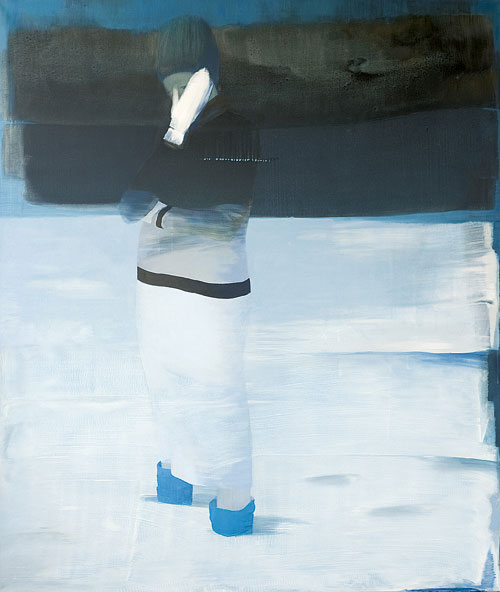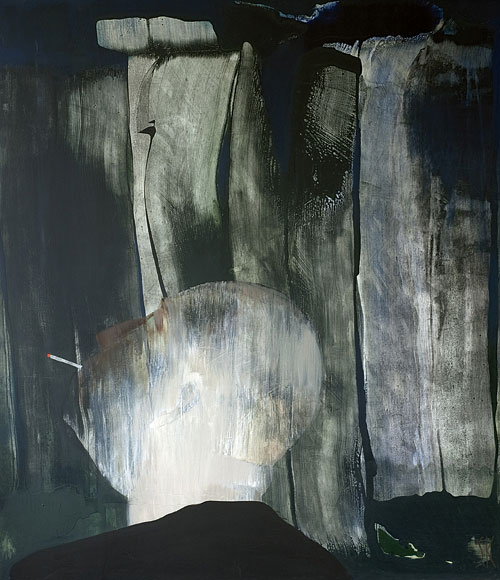|
|
| Existential aestheticism Stella Pelše, Art Historian Monday. Tuesday. Wednesday. Thursday. And Night... 29.03.–12.05.2012. Riga Gallery | |
| Art devotees need no introduction to Sandra Krastiņa. She arrived on the scene in the 1980s together with a group of other talented young artists (including Ieva Iltnere, Edgars Vērpis, Aija Zariņa, Ģirts Muižnieks and Jānis Mitrēvics) on the crest of the wave of neo-expressionism and a general renaissance in postmodernist painting. Krastiņa’s “energetically brutal sense of the epic”(1), like the art of her peers, has undergone deep transformations since then, and she has turned to other areas of activity as well. For Krastiņa, this included the establishment of the Latvian Artists’ Union Museum and work on the magazine Dizaina Studija (2006–2012), a unique and brave venture in the annals of Latvian periodicals that unfortunately succumbed victim to cold business calculation. | |
 Sandra Krastiņa. Freezing. Acrylic, oil on canvas. 200x170 cm. 2012 | |
| A new exhibition, following such a lengthy hiatus, is bound to arouse curiosity and raise the question of what has changed, and if so, how this should be assessed. However sceptical one may of it be after the death of the modernist cult of novelty, the search for the new is still an important component of art, and will probably never be replaced by anything else. Nevertheless, there is nothing to prevent the integration of innovation with earlier experience (individual or collective), and the viewer may find useful Mary Rawlinson’s description of painting as “the transposition of a style of seeing into a material embodiment from which that seeing can be recovered”(2). In answer to a question about what should be the focus of attention in the new works, the painter Krastiņa responds: “The figure. And in each picture the viewer must search for themselves.”(3) Transformation No. 1: Figuralism To some extent figuralism is nothing new, because Krastiņa made her entry into art with figural compositions cast in aggressively bright tones and quite directly corresponding to the dramatic atmosphere around the fall of the Soviet system, for example, ‘Fall in! Attention!’ (1986). The wave of abstraction typical of the 1990s which came into Latvia combined in original symbiosis with various neo-avant-garde trends, including the use of real space, was marked in Krastiņa’s case by bright blue and bands of varying widths living independently in spirals, overlappings and entwinings. This redefinition of abstract expressionism sat very well with, for example, the automatic dispassionate colour fields of Morris Louis. In the 2003 solo exhibition Vēja ziedi (‘Wind Flowers’), abstract fields were punctured by weird breaches, splits and gaps, confronting the dense plane with spatial illusions. The artist has emphasised that the turn to abstraction was a form of self-development without any special conceptual framework(4), however the episodic presence of little human figures indicated the potential for a return to the figure. The history of figuralism reveals the ugly manner in which this European “grand style” tradition has been used, in its time, for political ends, proposing the “living human figure” as the only bearer of national or class values. As the opposition between realism and modernism is consigned to history, there is no shortage of figuralism in the works of the new generation, exhibiting academic, Jugendstil-like aesthetic, poppishly (neo)realistic or laconically secretive New Simplicity(5) stylistic tendencies (Inga Meldere, Anda Lāce, Jānis Avotiņš). However, this does not mean that there is always a clear definition between the creators and the followers of a certain trend, leading to endless arguments about the “spirit of the age” that in some inexplicable way leads to a collective obsession with abstract or realistic or expressive or geometric expression. But to a certain extent it can be asserted that Krastiņa’s latest paintings are part of a definite rebirth of figuralism in Latvian art. Transformation No. 2: Close ups The human figure as can be seen in the works from the 1990s and early 21st century isn’t about figural composition quite yet – they are tiny, standardised figures, people as screws, each imprisoned in its own cell Sienas laukums (‘Wall Field’, 2002), marching in line Tuvumā jūra (‘The Sea Nearby’,1999) or transformed into a wall ornament as a kind of wallpaper pattern (the solo exhibition Glezna un glezna (‘A Painting and a Painting’, State Art Museum, 1999). There have been moments when these miniature figures unobtrusively interact with the exact geometric elements, almost in the style of Peter Halley’s neo-geo. Now, even if they don’t appear in all of the pictures, rather monumental figures take up the entire height of the canvas. In terms of silhouette, they are anatomically agile yet decoratively flattened, transparent and virtually merge with the background, while also retaining enough individuality so that those in the know can easily recognise the painter’s family members. Close up realism was already evident in the 2009 solo exhibition Vai kādam tas jāstāsta (‘Should anyone be told’ in the Gallery Daugava, and two works from this period were on show this time: Svētki (‘Festival’) and Leļļu deja (‘Dance of the Dolls’). The paper dolls and once so popular snowflakes that around the New Year decorated workplaces and homes introduce a nostalgic allusion to homemade festivities – even if provided by banal, fragile paper decorations. | |
 Sandra Krastiņa. It Will Be a Cold Night. Acrylic, oil on cardboard. 200x178 cm. 2011 | |
| The works in the new exhibition contain their share of riddles – are they abstractions, accidental mergings of fields or landscape motifs? Palaist vējā (‘Surrender to the Wind’, 2010) may hint at birds in flight, the horizon and a forest in the distance, or just as well it could be the viewer’s desire to see something familiar, as in clouds or cracked walls. Elsewhere it seems like the title of a work is an “anchor” to draw the viewer’s eyes to pleasing every day items. For example, Jaunais aizkars (‘The New Curtain’) could be something else altogether… In Ceļavējš (‘Travelling Wind’,2011), a young boy like the children’s book hero Dullais Dauka scans the horizon at the seashore, while Vasarniece (‘Summer Lady’, 2011) depicts an indolent creature with shoes and sunglasses in her hands. In contrast to these relaxed figures, ‘Domino’ (2011) and ‘Domino’ (2012) express energetic movement, where the focus of attention is on the mutations of the regular check patterns of a chessboard over a flowing, moving piece of clothing. The paint is airily watercolour-like and light: with the tonal range reduced down to an elegant interplay between black, white, and various bluish and greenish hues. The refined, nuanced and restrained flows of colours risk creating something akin to a beautifully aesthetic design object, but there is also tension in the subjugation of supposedly geometrically rational lines, bands or squares to the changing viewing angle and amorphously unforeseeable deformations. Time and meaning In the notes to the exhibition, the artist clearly stresses a philosophical existential reading along with a search for the meaning of life: “What happens to a person when apparently nothing is going on? Day follows day, and our life slips relentlessly by.” Time (every Monday, Tuesday and all the other days) may be both the most valuable thing a person has and a framework that makes everything else possible. This formulation appeals to the universal constants of the subjective experience of time; the realization that life does not lie ahead of us, but is happening right here and now with each moment chipping away at the remaining balance of time, is one that everybody discovers sooner or later, as it becomes ever more difficult to remember that sensation of endlessness and irritatingly slow passing of time experienced in childhood. What is to be done to stop being afraid of this speeding up of time and benefit from it instead? “In fact the whole antithesis between self and the rest of the world, which is implied in the doctrine of self-denial, disappears as soon as we have any genuine interest in persons or things outside ourselves. Through such interests a man comes to feel himself part of the stream of life, not a hard separate entity like a billiard-ball, which can have no relation with other such entities except that of collision. (..) Such a man feels himself a citizen of the universe, enjoying freely the spectacle that it offers and the joys that it affords… It is in such profound instinctive union with the stream of life that the greatest joy is to be found.”(6) Sandra Krastiņa’s figures, which have clearly merged with “the stream of life”, offer a surprisingly visual analogy of these reflections in a classic and completely un-banal book ‘The Conquest of Happiness’. First published in the distant 1930s, it could be of interest even to those who give a wide berth to the corner of the bookshop with titles such as “how to be rich and happy”. /Translator into English: Filips Birzulis/ 1 Osmanis, Aleksis. Robežas pārkāpjot: Identitātes labirintos. In the book: Latvijas Glezniecība. Laikmeta liecinieki: Mākslinieku savienības mākslas darbu kolekcija: 20. gadsimta 60., 70. un 80. gadi. Compiled by I. Baranovska. Riga: Latvijas Mākslinieku savienība, 2002, p. 215. 2 Art History Versus Aesthetics. Ed. by James Elkins. New York and London: Routledge, 2006, p. 139. 3 Krastiņa, Sandra. Bilde ir iemesls domāt. Pastnieks, 2012, No. 13, p. 4. 4 Rudzāte, Daiga. Sandra Krastiņa. Studija, 1999, No. 6, p. 9. 5 Vējš, Vilnis. Jaunā vienkāršība. 2000–… . Studija, 2010, No. 72, pp. 37–45. 6 Russell, Bertrand. The Conquest of Happiness. London and New York: Routledge, 2008, p. 175. | |
| go back | |







